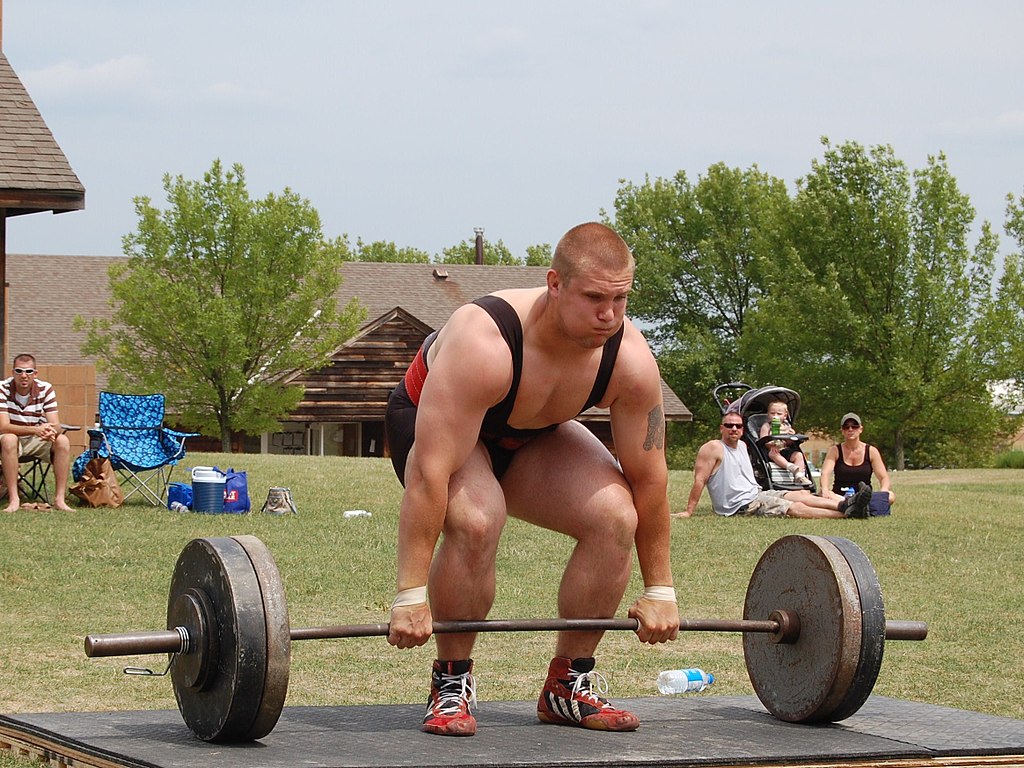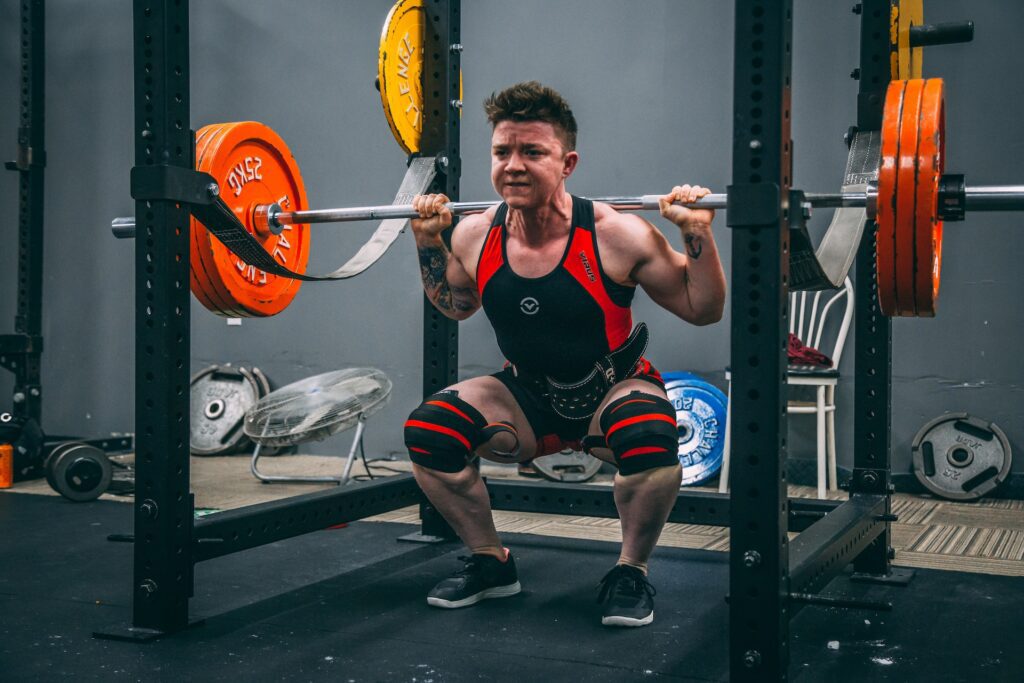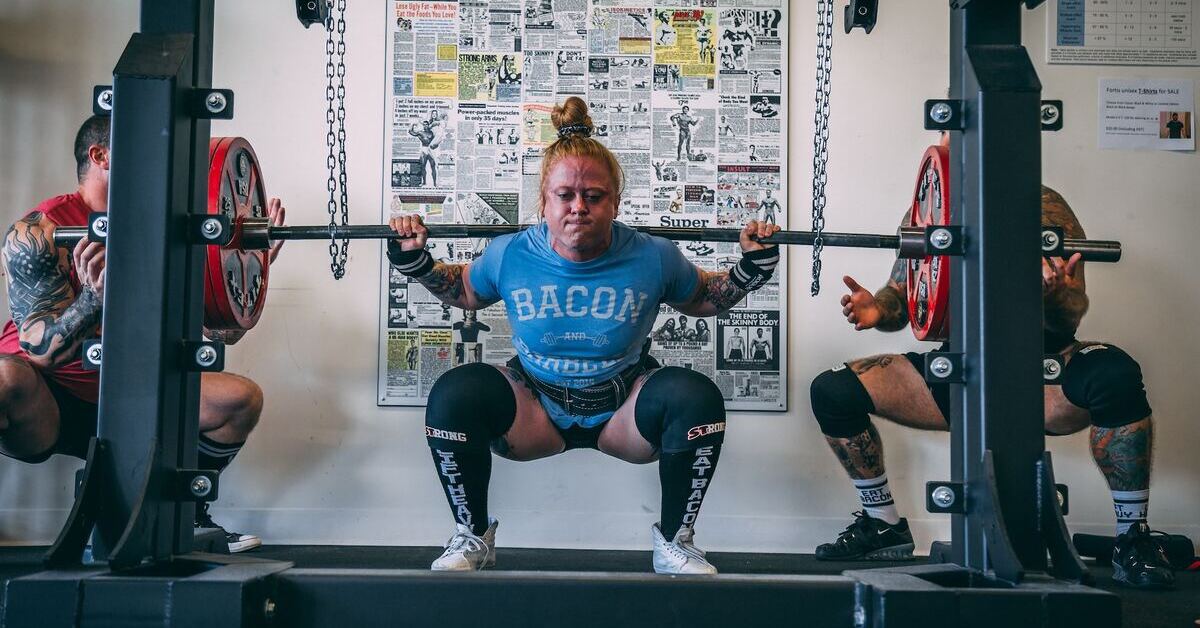It’s important to wear the correct type of shoes for lifting weights. Some lifters don’t think the type of shoes they wear matters, but they couldn’t be more wrong. Wearing proper lifting shoes enhances your performance and reduces your risk of injury while lifting weights.
Some lifters think wearing proper lifting shoes means wearing a pair of Olympic weightlifting shoes, but that’s not always true. The type of shoes you should wear depends on your training style. There are many instances where it would be better to lift in flat shoes.
Why wear flat shoes for lifting? In this article, we’ll answer this question by explaining what flat lifting shoes are and the advantages and disadvantages of wearing them. Additionally, we’ll be reviewing some of the best flat lifting shoes and answering a few frequently asked questions.
What Are Flat Lifting Shoes?

A flat lifting shoe is a strength training shoe with a 0-inch (or 0-millimeter) heel-to-toe drop. A shoe’s heel-to-toe drop is the difference between its heel and toe heights. The larger the heel-to-toe drop, the more elevated the heel is, and the smaller the heel-to-toe drop, the flatter the heel is.
Even though shoes with a 0-inch heel-to-toe drop are flat, the thickness of their soles can vary. The thicker a shoe’s soles are, the farther away from the ground your feet will be. This is because thicker-soled shoes have more material between your feet and the ground than thinner-soled shoes. Some shoes have very thin soles, making wearing them similar to being barefoot.
Examples of flat-sole lifting shoes are the Converse Chuck Taylor All Star and Sabo Deadlift PRO.
Advantages of Lifting in Flat Shoes

There are a few advantages to lifting in flat shoes. Whether or not these advantages apply to you depends on your training style. In this section, we’ll explain what these advantages are and who they’re useful for.
Stability
Your heels are closer to the ground in flat shoes than in heeled shoes. Some lifters prefer this because it enhances their sense of balance and stability, especially when performing squats (depending on the lifter’s squat style and ankle mobility) and deadlifts. Feeling more balanced and stable makes you more confident in your lifting form.
Flat shoes typically have wider toe boxes than heeled shoes, giving you more room to splay, or spread out, your toes. Splaying your toes increases the width of your base, which is your point of contact with the floor. The wider your base is, the better your stability.
Lifting Mechanics
Many lifters prefer using flat shoes for squats and deadlifts because heeled shoes alter the exercises’ mechanics. Heeled shoes shift your body forward in the bottom portion of both lifts, requiring more quadriceps involvement. Flat shoes allow you to keep your hips farther back, requiring less quadriceps involvement.
The deadlift is meant to train the posterior chain, so some lifters prefer to limit the amount of quadriceps involvement in the exercise. This is especially true for bodybuilders, who choose exercises to train specific muscle groups.
Some lifters prefer lifting in flat shoes because they believe flat soles improve force production.
Range of Motion
Heeled lifting shoes increase the deadlift’s range of motion, which means you’ll have to pull the bar a longer distance to complete a repetition. The longer an exercise’s range of motion is, the more challenging the exercise will be.
If your goal is to deadlift as much weight as possible, use flat-soled shoes. Making the exercise more challenging will negatively affect your performance. This is one of the reasons why powerlifters like to deadlift in flat shoes.
Disadvantages of Lifting in Flat Shoes

Depending on the exercises you’ll be doing, training in flat shoes might not be ideal. If you’re going to do Olympic lifting exercises or CrossFit WODs, you should train in a different type of shoe. In this section, we’ll explain the drawbacks of lifting in flat shoes.
Squatting With Limited Ankle Mobility
If you have trouble squatting below parallel, it could be because you have limited ankle mobility. Squatting in flat shoes isn’t ideal for lifters with limited ankle mobility.
One of the benefits of heeled squat shoes is that they help lifters with limited ankle mobility achieve proper squat depth. The elevated heel shifts the body forward at the bottom of the squat, reducing the amount of ankle dorsiflexion necessary to reach full depth. For this reason, squatting in flat shoes isn’t ideal for some lifters.
CrossFit
CrossFit workouts can include various types of exercises. When performing explosive exercises, such as box jumps and jumping rope, it’s better to have a slightly elevated heel. The slight heel elevation will allow you to stay on the balls of your feet but not shift your body so far forward that your performance is negatively affected. Being flat-footed isn’t ideal for performing explosive exercises, so wearing flat shoes isn’t recommended.
An example of a CrossFit shoe with a slightly elevated heel is the Nike Metcon 8.
Should You Lift in Flat or Heeled Shoes?

When it comes to flat or heeled lifting shoes, one isn’t better than the other. Determining which type of shoes you should get depends on the types of exercises you’ll be performing. Below, we listed the types of exercises that are performed in powerlifting, Olympic weightlifting, and CrossFit and what shoes to wear when performing them.
Powerlifting
The competition lifts in powerlifting are the squat, bench press, and deadlift. If you’re going to compete in powerlifting, lifting in flat shoes is usually the best option:
- Power squat: If you have good ankle mobility, flat shoes are good for squatting. If you have bad ankle mobility, you might want to buy a pair of heeled shoes for squatting.
- Bench press: Some lifters prefer to bench press in heeled shoes because they have trouble making contact with the floor, but for most, flat shoes will suffice.
- Deadlift: It’s best to deadlift in flat shoes because they help with the mechanics of the lift.
- Powerlifting assistance exercises: For squat assistance exercises, use the shoes you chose to squat in. For bench press assistance exercises, use the shoes you chose to bench in. For anything else, use flat shoes.
Olympic Weightlifting
The clean and jerk and snatch are the competition lifts in Olympic weightlifting. If you’re going to compete in Olympic weightlifting, you should lift in Olympic weightlifting shoes:
- Clean and jerk: The heeled soles of Olympic weightlifting shoes allow you to achieve proper depth when performing Olympic weightlifting exercises, so we recommend using them.
- Snatch: Same as clean and jerk.
- Olympic squat and other Olympic weightlifting assistance exercises: Same as clean and jerk.
CrossFit
In CrossFit, many different types of exercises are performed, such as powerlifting, Olympic weightlifting, and calisthenics exercises. To efficiently perform such a wide variety of exercises, it’s best to use a lifting shoe with a low, or slightly elevated, heel. This way, the heel isn’t too high for exercises like deadlifts or plyometrics but is high enough to increase a lifter’s ankle mobility for squats or snatches.
What to Look for in Flat Lifting Shoes

There are important things to look for when shopping for a good pair of flat-soled lifting shoes. If you choose a pair of shoes without doing your due diligence, you might choose the wrong pair. In this section, we’ll be explaining the things you should consider before making a decision.
No Heel-to-Toe Drop
For a lifting shoe to be considered flat, it has to have a 0-inch heel-to-toe drop. If you decided to get a pair of flat-soled lifting shoes, it was probably to use them for exercises that you need a flat heel for, such as the deadlift, or because you prefer to lift in a flat heel to accommodate your lifting style.
Regardless of your reason for wanting flat lifting shoes, it’s important to make sure that the shoes you choose are actually flat and don’t have slightly-elevated heels. Shoes with slightly-elevated heels can look similar to flat shoes, so it’s easy to mistake one for the other.
Non-Compressible Soles
Whether the shoes are flat or heeled, it’s important that the soles are non-compressible. Non-compressible soles are essential for strength training because compressible soles allow your feet to sink into them, which can negatively affect your stability and ability to produce force.
Ankle Support
If you have a history of ankle injuries or want your ankles to feel more stable while lifting, you should choose a pair of shoes that offer ankle support.
High top lifting shoes provide ankle support, but the amount of support they provide will differ depending on the shoes’ quality. For example, the NOBULL High Top Trainers are made of high-quality material and provide good ankle support, while the Converse Chuck Taylor All Star High Tops are made of canvas and provide little to no ankle support.
Good Traction
The outsoles of lifting shoes need to have good traction. Lifting weights in shoes with inadequate traction can cause you to slip, which can potentially lead to you injuring yourself.
Slipping is a major concern when sumo deadlifting because your feet are so close to the weight plates. If your feet slip during the concentric portion of the lift (lifting the weight), you might drop the weight on them during the eccentric portion of the lift (lowering the weight). It’s not uncommon for lifters to suffer from foot fractures or broken bones while sumo deadlifting.
Durability
Your shoes’ durability is important because it determines how long they’ll last. They should be designed to withstand the type of workouts you’ll be doing, whether that’s Olympic weightlifting, powerlifting, or anything else. A good pair of lifting shoes can last you a few years if you take care of them.
Best Flat Shoes for Lifting
Now that we’ve explained what flat lifting shoes are, their pros and cons, and what to consider when choosing a pair, we’ll recommend a few. Below are some of the best flat shoes for lifting.
Converse Chuck Taylor All Star
If you’re looking for a solid, stylish pair of lifting shoes that won’t break the bank, the Converse Chuck Taylor All Star is a great choice. Their flat soles make them a good option for a flat lifting shoe. Their outsoles provide traction, helping you maintain your footing while lifting. Chuck Taylors come in many colors and they’re also available in high or low tops.
Chuck Taylors aren’t made for strength training, they just happen to fit some of the criteria for flat strength training shoes. They aren’t as durable as actual strength training shoes, nor do they provide the same amount of support. If you’re looking for a shoe that provides ankle support and will last a long time, you should look elsewhere.
Vans Classic Skate Shoe
The Vans Classic Skate Shoe is another classic shoe that’s stylish and budget-friendly. They’re known for their clean, simple look and are also solid shoes to wear when lifting. Vans’ soles won’t compress, unlike running shoes, and they have a 0” heel-to-toe drop, which means your feet will be flat on the ground when you’re lifting. The classic waffle tread on the shoes’ outsoles provides decent traction.
Vans Classic Skate Shoes have a thick rubber base. While that base is flat, it’ll leave about an inch of space between your feet and the ground. Lifters who prefer to be closer to the ground might want a shoe with a thinner base.
Adidas The Total
The Adidas The Total is designed to be a weight training shoe. Its sleek design is meant to fit your foot comfortably without being too loose. The shoe’s midsoles are flat and non-compressible, so they’ll remain stable under heavy weight. The base of the shoe is thin, allowing you to be closer to the ground, and its outsoles provide good traction to prevent slipping.
If you’re going to be cross-training, The Total might not be the best option because it’s designed for weight training. Also, it’s a bit expensive for a beginner shoe but can be a great option for a seasoned lifter.
Sabo Deadlift PRO
As the name implies, the Sabo Deadlift PRO is designed for deadlifting. It’s a stable, durable shoe that provides excellent support and traction. The soles of this shoe are thin, keeping the wearer close to the ground. Its high-top style and ankle strap prevent ankle fold-over and its rubber outsole will prevent you from slipping. Because it was designed for deadlifts, it’s the perfect choice for a powerlifter. Many regard the Sabo Deadlift PRO as the best deadlift shoe there is.
The PROs aren’t cheap, but if you’re a serious lifter focused on deadlifts, they’re worth the cost. If you’re looking for a more versatile shoe that can be used for multiple exercises, you should look elsewhere.
Vivobarefoot Primus Lite III
Many lifters prefer to lift in “barefoot shoes”, minimalist shoes that make the wearer feel like they’re barefoot. The Vivobarefoot Primus Lite III is a barefoot shoe that’s foot-shaped, flexible, and can be used in various types of training. Its rubber soles are only 4mm thick, keeping the wearer close to the ground, and they provide support and traction. Vivobarefoot is an eco-friendly company. Once the shoes are worn out, you can ship them to Vivobarefoot to be made into new shoes.
Because these shoes are so versatile, they may not be the best option for some weight training exercises, particularly Olympic weightlifting exercises. Also, barefoot shoes aren’t the best type of shoes for beginner lifters.
Frequently Asked Questions

Are Flat Shoes Better for Lifting?
Whether flat shoes are better for lifting will depend on the training style of the lifter using them. Flat shoes might not be good for an Olympic weightlifter, but they’d be good for a powerlifter. If you’re going to be doing Olympic lifts or have bad ankle mobility and plan on doing squats, get a pair of heeled shoes. If you’re going to be doing deadlifts, get a pair of flat shoes.
Should You Deadlift in Flat Shoes?
Yes, you should deadlift in flat shoes. Flat shoes give you the stability and support necessary for deadlifting. Heeled shoes make deadlifting harder by shifting your body forward and increasing your range of motion.
Can I Lift in Running Shoes?
We don’t recommend lifting in running shoes. Running shoes have compressible soles, making them suboptimal for lifting. Lifting weights in running shoes can negatively affect your lifting performance and possibly cause you to injure yourself.
The Bottom Line: Why Wear Flat Shoes for Lifting?
As we explained in this article, lifting weights in the correct type of shoes is paramount to improving performance and reducing injury risk. Wearing flat shoes can be beneficial (or detrimental) depending on the type of training you’re doing.
If you’re going to be deadlifting, it’s best to use flat shoes. If you want to perform hip-dominant squats and have the ankle mobility to do so, you should use flat shoes. If you’re going to be doing snatches and clean and jerks or Olympic-style high bar squats, you should use heeled shoes. If you’re going to be doing CrossFit, you should use CrossFit shoes with slightly elevated heels.
For many lifters, it would be best to buy a pair of all three – flat, heeled, and slightly-elevated heel shoes. This way, you’ll always have the correct type of shoes available, no matter what type of training you’re doing.
Jay is not just a writer; he’s a seasoned strength enthusiast with two decades of dedicated training under his belt. Whether he’s crafting engaging articles, reviewing cutting-edge equipment, or sharing his personal fitness anecdotes, Jay’s writing resonates with a diverse audience, from seasoned gym enthusiasts to beginners eager to embark on their own transformative fitness paths.





